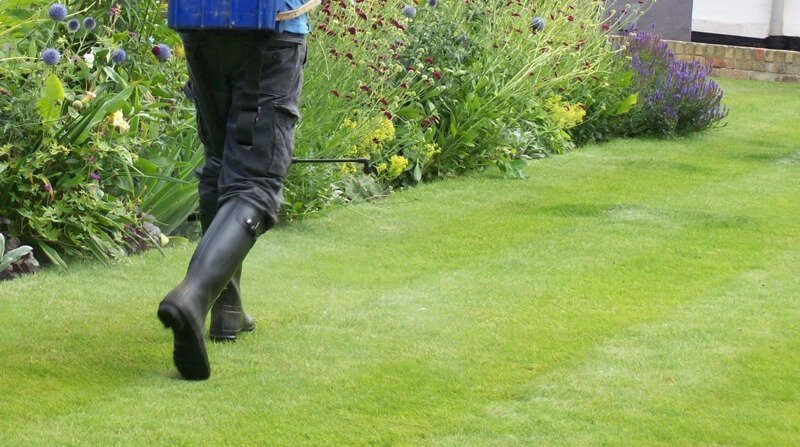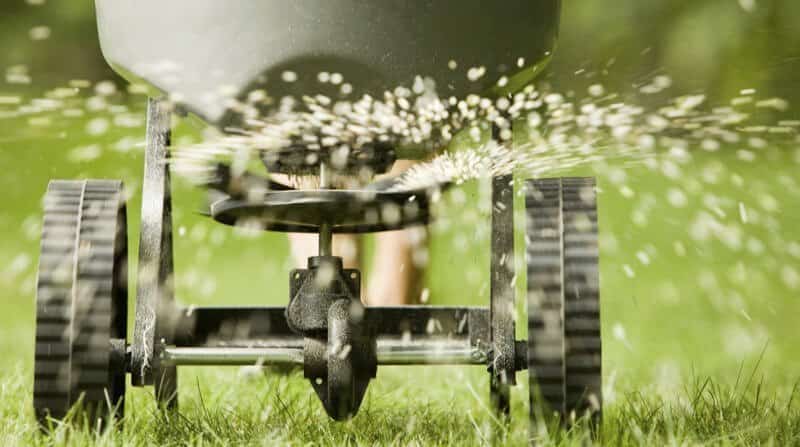In this article, I’ll explain when to feed your lawn.
See, many gardeners feed their lawns either too much, not enough or use the wrong type of fertilisers at the wrong time of year.
If you’re guilty of this then not even the best fertiliser will help.
So I’ll explain the problems with feeding your lawn too infrequently and what happens when you fertilise too often. Then I’ll explain the dangers of using the wrong type of fertiliser at the wrong time.
Then I’ll show you a very simple annual lawn feeding regime which you can follow to create and maintain a lush, healthy sward all year round.
The Problems With Over and Under Feeding
Despite claiming to know how to feed your lawn with granular fertiliser and how to apply liquid lawn feed, many gardeners do it at opposite ends of the extreme. Either by not feeding anywhere near as often as they should or completely overdoing it.
Each creates a different set of problems.
Not Feeding Regularly Enough
Most lawn owners don’t feed their lawns enough and the reasons for this are many.
The most common reason is that many people who own lawns, either aren’t interested in spending the time to care for them or don’t have the time to dedicate to it.
Either way, underfeeding creates a deficiency in nutrients. Mainly in Nitrogen, Phosphate and Potassium – all of which aid in leaf growth and root development.
When a lawn lacks these nutrients, the grass can’t function as it should. Leaf growth slows right down and the roots become weak.
This means the grass can’t repair itself when you mow, especially if you mow too short and it becomes more susceptible to disease.
Over time you’ll notice your lawn become thinner and more sparse. You might even see parts of the lawn turning yellow or brown and in the worst cases, the grass could die off altogether. This creates room for weeds and moss to invade.
Overfeeding a Lawn
On the other end of the scale are people who feed their lawns too often. This creates a different set of problems.
Firstly, it creates regular surge growth which means you’ll end up having to cut the grass more often than you would otherwise need to.
Secondly, this rapid growth also affects the roots which also grow too quickly. Not only can this weaken them but the microbes in the soil can’t break down the dead roots in the thatch layer quickly enough to make room for the new ones.
The result is a very excessive build-up of lawn thatch which creates a barrier that prevents, water air and nutrients from getting into the soil.
Your lawn will become spongs and soggy, especially when it’s wet as water just sits on the surface.
But this heavy thatch layer creates another problem.
In order for the grass to access the water, air and nutrients of which it is being starved, the grass will root directly into the thatch layer instead of rooting deeply into the soil.
When the weather gets hot and dry, the thatch completely dries out. This means your lawn suffers from drought conditions, turning brown and dying off. Again, creating room for weeds and moss to invade.
In order to combat all of this, you’ll need to scarify your lawn more often than necessary.
A Simple, Annual Lawn Feeding Regime

So how much should you feed your lawn?
By following this lawn feeding guide, you’ll get an understanding of when to feed your lawn, how often and with which type.
Apply your feed after cutting the grass. This will give your lawn a chance to absorb it before you cut it next.
Spring
Choose a spring fertiliser like Scotts Spring/Summer Lawn Builder Lawn Food . This is purely a fertiliser.
If you prefer, you can use a feed, weed and moss killer like Evergreen 4-in-1 Complete . However, you should only apply this twice a year so wait until the autumn before applying it again.
Plan to apply this in April once you’ve given your lawn its first couple of cuts and when the Daffodils are fully open.
A good spring fertiliser will help your lawn recover from the stresses of winter and bring it back to life.
Summer
Around 8-12 weeks after applying a Spring lawn feed, apply Scotts Spring/Summer Lawn Builder Lawn Food again. It’ll give your lawn the nutrients it needs to get through the summer.
If the weather is hot and dry, wait for rain and apply after a good downpour. Alternatively, give your lawn a good soak prior to applying.
If your lawn lack colour and vibrancy during the summer, give it a dose of Miracle-Gro liquid lawn feed . This will give it a nice boost of green colour.
Autumn
September is the ideal time to apply and Autumn/Winter Lawn Food. Again, let the weather dictate when you apply it but wait until the rains start.
Alternatively, apply a second dose of Evergreen 4-in-1 Complete.
Don’t apply fertilisers spring/summer with high nitrogen content in the autumn. It can result in the onset of diseases like Fusarium as the weather gets colder.
Winter
Apply another dose of Scotts Autumn/Winter Lawn Food during December or January.
To protect your lawn through the winter months, you might also give your lawn a dose or tow of Iron Sulphate.
This will;
- Harden the turf and protect it against the stresses of winter
- Give your grass a nice green boost
- Kill any moss that starts to creep in
WARNING: Applying Ferrous Sulphate will blacken any moss in your lawn. If you apply it in hot, dry conditions, it could also blacken the grass. Therefore only apply Ferrous Sulphate in cool, wet conditions.
In Conclusion
In order to stay in really good health, your lawn only really needs four feeds a year.
You can also give your lawn an additional dose of soluble lawn feed in the spring and iron sulphate in the winter but it’s often not necessary. If you’re unsure, it’s best not to do it at all.
Any more than this and you run the risk of overfeeding which, ultimately, creates more problems and more work.

